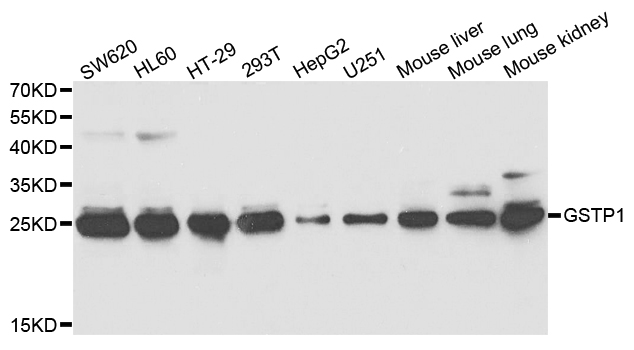GSTP1 antibody [N1N2], N-term
GTX100299
ApplicationsImmunoFluorescence, Western Blot, ImmunoCytoChemistry, ImmunoHistoChemistry, ImmunoHistoChemistry Paraffin
Product group Antibodies
TargetGSTP1
Overview
- SupplierGeneTex
- Product NameGSTP1 antibody [N1N2], N-term
- Delivery Days Customer9
- Application Supplier NoteWB: 1:1000-1:10000. ICC/IF: 1:100-1:1000. IHC-P: 1:100-1:1000. *Optimal dilutions/concentrations should be determined by the researcher.Not tested in other applications.
- ApplicationsImmunoFluorescence, Western Blot, ImmunoCytoChemistry, ImmunoHistoChemistry, ImmunoHistoChemistry Paraffin
- CertificationResearch Use Only
- ClonalityPolyclonal
- Concentration1 mg/ml
- ConjugateUnconjugated
- Gene ID2950
- Target nameGSTP1
- Target descriptionglutathione S-transferase pi 1
- Target synonymsDFN7, FAEES3, GST3, GSTP, HEL-S-22, PI, glutathione S-transferase P, GST class-pi, GSTP1-1, deafness, X-linked 7, epididymis secretory protein Li 22, fatty acid ethyl ester synthase III
- HostRabbit
- IsotypeIgG
- Protein IDP09211
- Protein NameGlutathione S-transferase P
- Scientific DescriptionGlutathione S-transferases (GSTs) are a family of enzymes that play an important role in detoxification by catalyzing the conjugation of many hydrophobic and electrophilic compounds with reduced glutathione. Based on their biochemical, immunologic, and structural properties, the soluble GSTs are categorized into 4 main classes: alpha, mu, pi, and theta. This GST family member is a polymorphic gene encoding active, functionally different GSTP1 variant proteins that are thought to function in xenobiotic metabolism and play a role in susceptibility to cancer, and other diseases. [provided by RefSeq]
- Storage Instruction-20°C or -80°C,2°C to 8°C
- UNSPSC12352203
References
- Chen JY, Chou HC, Chen YH, et al. High glucose-induced proteome alterations in hepatocytes and its possible relevance to diabetic liver disease. J Nutr Biochem. 2013,24(11):1889-910. doi: 10.1016/j.jnutbio.2013.05.006Read this paper





![IHC-P analysis of human liver using GTX01884 GSTP1 antibody [LW29]. Note staining of bile ducts.](https://www.genetex.com/upload/website/prouct_img/normal/GTX01884/GTX01884_20200811_IHC-P_98_w_23053121_586.webp)
![FACS analysis of K562 cells using GTX83077 GSTP1 antibody [3F2C2]. Green : GSTP1 Purple : negative control](https://www.genetex.com/upload/website/prouct_img/normal/GTX83077/GTX83077_20170912_FACS_w_23061322_657.webp)